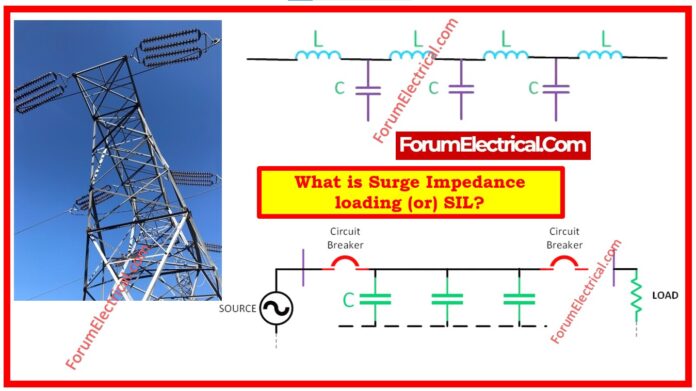- What is Surge Impedance?
- Surge Impedance Formula (SIL Formula)
- Important Information on Surge Impedance
- What is Surge Impedance Loading (SIL)?
- Factors affecting SIL
- Different Techniques to reduce L
- What is Characteristic Impedance (Zc)?
- Surge Impedance of a Transmission Line
- Application of Surge Impedance Loading (SIL)
What is Surge Impedance?
Surge impedance, also referred to as characteristic impedance, is a term utilized in the analysis of the electrical transmission lines.
It is defined as the voltage/current ratio of a moving wave on a line. Surge impedance is especially relevant in the presence of high-frequency signals (or) transient phenomena like as lightning strikes or switching surges.
Surge Impedance Formula (SIL Formula)
The formula for surge impedance (Z0)
(Z0) = √(L/C)
Where,
L – Inductance/Length &
C – Capacitance/Length
of transmission line.
Thus, from the given formula, we clearly observe two key conclusions.
- The surge impedance of a transmission line is determined by its inductance and capacitance.
- The surge impedance is independent of transmission line’s length.
In this post, we will explore the concept of surge impedance loading.
Important Information on Surge Impedance
- The surge impedance for transmission line (overhead) is 400Ω (Z0=400Ω).
- The surge impedance for underground cables is 40Ω (Z0=40Ω).
- Pure inductors have infinite surge impedance (Z0=∞) since their capacitance is zero.
- A pure capacitor has no surge impedance (Z0=0) since its inductance is zero.
- Transformers typically have a surge impedance of around (Z0=5000Ω).
What is Surge Impedance Loading (SIL)?
Surge impedance loading (SIL) can be described as the amount of power delivered when the load connected to transmission line equals the surge impedance.
Surge Impedance Loading (SIL) = Vs2/Z0 (W)
Where,
Vs = source voltage (or) operating voltage, and
Z0 = surge impedance.
In other terms, SIL is the megawatt power delivered by a load with an impedance equal to the transmission line’s surge impedance (Z0).
So we can express it as,
SIL = 3 Vph Iphcosφ
The load is resistive, therefore cosφ=1
IPh = Vph/R = Vph/Z0 = VL/√3 Z0
SIL = 3×VL/√3×VL//√3Z0 = VL2/Z0
SIL = VR2/Z0= VS2/Z0=VS2√C/L
Where
VS and VR represent line voltage
C & L represent phase value
Factors affecting SIL
Surge impedance loading (SIL) is proportional to the square of source (or) line voltage.
SIL ∞ VS2
SIL is proportional to square root of capacitance.
SIL ∞ √C
SIL is inversely proportional to square root of inductance.
SIL ∞ 1/√C
Different Techniques to reduce L
The different methods to reduce L include:
- By utilizing parallel lines,
- Utilizing series capacitance,
- Using bundled conductor.
What is Characteristic Impedance (Zc)?
It is square root of the ratio of the series impedance to the shunt admittance. It indicates that characteristic is the transmission line’s impedance at any given point.
Zc = √Z/Y
Where
Zc – Characteristic Impedance
Z – Series Impedance
Y – Shunt Admittance
Surge Impedance of a Transmission Line
The surge impedance of a transmission line is an important element in determining wave propagation over the line.
It controls how voltage & current waves react as they move along the transmission line.
Transmission line surge impedance ranges from 200-400Ω based on voltage class, with a phase angle of 0-15 degrees. The table below provides typical HV & EHV overhead transmission line surge impedance values.
| Overhead Transmission Lines | Average of Surge Impedance (Z0) | |||
| Rated Voltage (kV) | Z0 | Surge Impedance Load (MW) | ||
| EHV | 69 | 360-393 | 14-13 | ~400Ω |
| 115 | 370-404 | 35-32 | ||
| 138 | 371-404 | 51-47 | ||
| 161 | 379-406 | 68-64 | ||
| 230 | 365-394 | 145-134 | ||
| HV | 345 | 280-366 | 425-325 | ~300Ω |
| 500 | 233-294 | 1075-850 | ||
| 765 | 254-266 | 2300-2200 | ||
For overhead lines, apply the following rule of thumb to calculate series inductance & shunt capacitance.
| Overhead Transmission Lines | |||
| Average Inductance | Average Capacitance | Average of Surge Impedance (Z0) | |
| HV (69kV-230kV) | ~2.1mH/Mile | ~14nF/Mile | ~400Ω |
| ~1.3mH/KM | ~8.75nF/KM | ||
Application of Surge Impedance Loading (SIL)
- SIL is essential for establishing transmission lines that maintain voltage stability and provide efficient power delivery.









